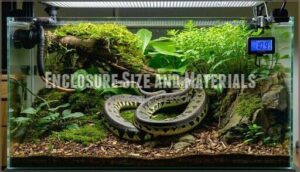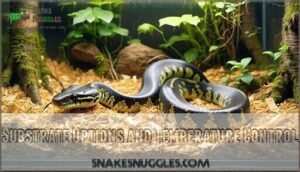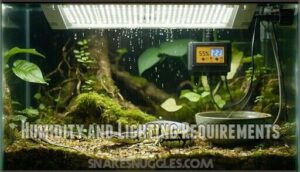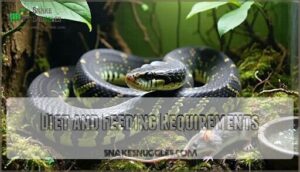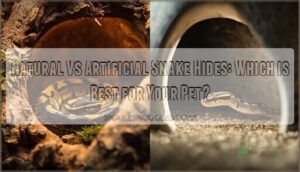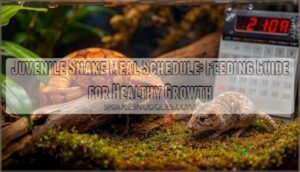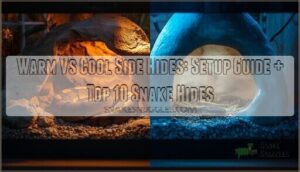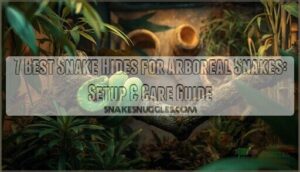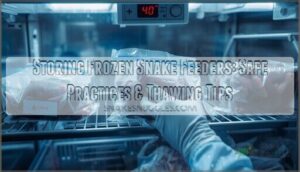This site is supported by our readers. We may earn a commission, at no cost to you, if you purchase through links.
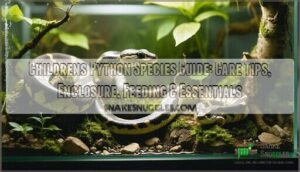
You’ll find these non-venomous beauties in northern Australia’s rocky outcrops and woodland areas. They typically reach 30-40 inches long with stunning brown and cream patterns that help them blend into their natural habitat.
As nocturnal hunters, they’re surprisingly active and curious pets. Their manageable size means you won’t need a massive enclosure, but they still require proper heating, humidity, and hiding spots to thrive.
These adaptable snakes are known for their calm temperament and relatively simple care requirements, though specific environmental conditions make all the difference.
Table Of Contents
- Key Takeaways
- Childrens Python Overview
- Choosing The Right Enclosure
- Top 8 Childrens Python Essentials
- 1. Large reptile terrarium glass tank
- 2. Forest Floor Animal Bedding Material
- 3. Reptile Terrarium Heating Pad Combo
- 4. Ceramic Heat Emitter For Reptiles
- 5. Reptisun Led Terrarium Lighting Hood
- 6. Reptile Terrarium Heat Lighting Timer
- 7. reptile terrarium humidifier misting system
- 8. Natural Green Sphagnum Moss Terrarium
- Childrens Python Care and Maintenance
- Childrens Python Growth and Development
- Frequently Asked Questions (FAQs)
- Are children’s Python a good snake?
- What is the scientific name of a children’s Python?
- What is a children’s Python?
- How big do children’s pythons get?
- Can children pythons live in Australia?
- Where do children’s Python Live?
- What are the different types of children’s pythons?
- Are children’s pythons good for beginners?
- What is a T+ children’s Python?
- What do I need for a children’s Python?
- Conclusion
Key Takeaways
- You’ll need an appropriately sized terrarium (40+ gallons), proper heating system with temperature gradient (78-88°F), and humidity control (50-60%) to create a thriving environment for your Children’s python.
- These docile, non-venomous snakes reach only 3-4 feet long and make excellent beginner pets due to their calm temperament and straightforward care requirements.
- Feed your python frozen mice appropriately sized to match their thickest body section – juveniles eat weekly while adults require feeding every 10-14 days.
- Regular health monitoring is essential – watch for respiratory issues, mites, shedding problems, and maintain consistent environmental conditions to support their 15-20 year lifespan.
Childrens Python Overview
You’ll find Australia’s smallest python species, Antaresia childreni, makes an excellent choice for beginner snake keepers with its calm temperament and straightforward care requirements.
This nonvenomous constrictor reaches just 3-4 feet in length and adapts well to captive environments when you provide proper heating, humidity, and secure enclosure setup.
Scientific Name and Origin
Meet the Antaresia childreni, better known as the Children’s python – a fascinating Australian native that’s captured reptile enthusiasts’ hearts worldwide.
Australia’s tiniest python packs maximum charm in a perfectly manageable 4-foot package.
Named after John George Children, a 19th-century British zoologist who first described this python species, these Australian snakes showcase remarkable geographic distribution across Northern Territory, Queensland, and Western Australia.
This taxonomic classification places them among Australia’s smallest constrictors, making species discovery particularly exciting for researchers studying Australian origins.
They are found in a variety of habitats, and their discovery has been particularly exciting for those interested in the field.
Physical Characteristics and Adaptations
Childrens pythons showcase remarkable adaptations that make them efficient predators.
Their slender build reaches 3-4 feet, featuring reddish-brown coloration with distinctive dark markings that fade as they mature.
These python species excel at camouflage in their natural environment.
- Color Patterns: Reddish-brown base with darker leaf-like markings that provide excellent camouflage
- Scale Types: Smooth, shiny scales that aid movement and enhance their stealthy hunting approach
- Heat Sensing: Specialized pits near the mouth detect warm-blooded prey in darkness
- Constrictor Methods: Powerful muscles wrap around prey, applying precise pressure to subdue victims
- Semiarboreal Build: Lean body structure supports climbing behavior and traversing various terrains
Understanding proper temperature gradient controls is vital for maintaining a healthy environment for childrens pythons.
Natural Habitat and Distribution
Understanding their native distribution helps you recreate their natural environment.
Australian natives span Queensland’s rocky outcrops, Northern Territory woodlands, and Western Australia’s caves.
Their geographic range covers diverse climate zones from humid monsoon forests to dry savannas.
| Habitat Types | Climate Zones |
|---|---|
| Rocky outcrops with crevices | Warm, humid tropical regions |
| Woodland areas with debris | Semi-arid savanna climates |
| Cave systems for shelter | Monsoon-influenced zones |
| Termite mounds and hollows | Temperature-stable microclimates |
Choosing The Right Enclosure
Selecting the right enclosure for your Children’s python forms the foundation for successful long-term care and your snake’s overall well-being.
You’ll need to examine three critical factors: proper sizing and durable materials, appropriate substrate choices with reliable temperature control, and ideal humidity levels paired with suitable lighting systems.
Enclosure Size and Materials
Selecting the right tank size sets the foundation for your python’s well-being. Adult Children’s pythons need minimum dimensions of 36 inches long, 18 inches wide, and 18 inches high, though larger enclosures promote natural behaviors.
When designing an enclosure, consider the enclosure size requirements to guarantee the snake’s comfort and safety.
Essential enclosure considerations:
- Glass tanks – Provide excellent visibility but require secure tops and additional insulation for heat retention
- PVC panels – Offer superior heat retention, lightweight construction, and easy customization for ventilation systems
- Melamine construction – Budget-friendly option that maintains stable temperatures when properly sealed against moisture
- Front-opening designs – Reduce escape risks and minimize stress during maintenance compared to top-opening enclosures
Substrate Options and Temperature Control
Once you’ve secured your enclosure, focus on substrate materials that support healthy thermoregulation.
Python habitat success depends on proper temperature gradients and substrate choices that maintain humidity levels without compromising ventilation systems.
For superior results, consider using safe snake substrates to guarantee the well-being of your pet.
| Substrate Type | Temperature Range | Maintenance |
|---|---|---|
| Aspen shavings | 78-88°F gradient | Replace monthly |
| Cypress mulch | 80-90°F basking | Spot clean daily |
| Coconut fiber | 72-85°F cool side | Full change quarterly |
| Paper towels | Monitor with probe | Replace weekly |
| Reptile carpet | Thermostat controlled | Wash bi-weekly |
Choose heating options like ceramic emitters or heat pads to create proper temperature control.
Your snake substrate options should retain moisture while allowing airflow for ideal enclosure setup.
Humidity and Lighting Requirements
Proper humidity control maintains your snake’s respiratory health and successful shedding cycles.
Target humidity levels between 50-60%, increasing to 70% during shed periods using misting systems or water bowls.
- Climate Management: Monitor humidity with digital hygrometers and adjust ventilation systems accordingly
- Lighting Requirements: Provide 12-hour day/night cycles using LED terrarium hoods or ceramic heat emitters
- Temperature Gradient: Maintain proper lighting options alongside your existing temperature control setup
Top 8 Childrens Python Essentials
Setting up your Children’s python properly requires the right equipment to create a healthy, secure environment.
You’ll need these eight essential items to guarantee your snake thrives in captivity and maintains prime health throughout its 20-30 year lifespan.
1. Large reptile terrarium glass tank
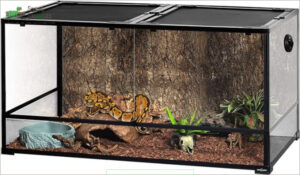
Your Children’s python needs a spacious home that won’t cramp their natural behaviors.
Looking at your content about Children’s pythons, here’s a short, engaging blockquote that matches the tone:
Give your python the space it needs to explore, climb, and truly thrive in captivity.
A 114-gallon glass terrarium measuring 47.2"L x 23.6"W x 23.6"H provides over 1,000 square inches of floor space—perfect for these active climbers.
The tempered glass construction offers durability and crystal-clear viewing, while front sliding doors with security buckles prevent escapes.
You’ll appreciate the raised bottom for ventilation and the removable screen top for easy maintenance.
Best For: Reptile and amphibian owners needing a secure, spacious, and easy-access enclosure for medium-sized species like Children’s pythons.
- Mesh top may need reinforcement for heavier animals or large snakes.
- Two people required for assembly due to weight and size.
- Humidity and temperature may require extra insulation and equipment.
- Durable tempered glass with 360° viewing for easy monitoring.
- Spacious floor area with raised bottom for airflow and cable management.
- Front sliding doors and removable screen top simplify maintenance.
2. Forest Floor Animal Bedding Material
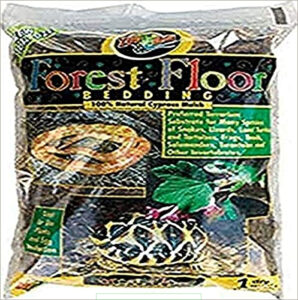
Cypress mulch creates the ideal foundation for your Children’s python’s home, mimicking Australia’s natural forest floor conditions.
You’ll appreciate how this substrate retains moisture effectively, maintaining humidity levels between 50-60% without frequent misting.
The natural composition prevents respiratory irritation while allowing natural burrowing behaviors that reduce stress.
Unlike artificial alternatives, forest floor bedding supports healthy shedding cycles and provides antimicrobial properties that keep your enclosure cleaner longer.
Maintaining proper humidity is key, as stuck shed is common if humidity is too low.
Best For: Reptile owners seeking a natural, low-dust bedding that retains humidity and supports healthy behaviors in pythons, tortoises, and other terrarium species.
- Maintains stable humidity, reducing the need for constant misting.
- Encourages natural burrowing and stress-reducing behaviors.
- Antimicrobial and dust-free, minimizing health risks for sensitive reptiles.
- Slightly more expensive than basic substrates, especially for larger enclosures.
- Occasionally contains large pieces that may need removal.
- Requires regular spot cleaning and periodic full replacement to prevent mold.
3. Reptile Terrarium Heating Pad Combo
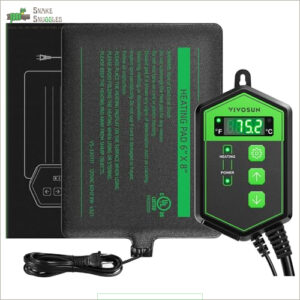
Under-tank heating pads paired with digital thermostats provide essential belly heat for your Children’s python, mimicking the warm rocks they’d seek in Australian woodlands.
You’ll maintain precise temperatures between 85-90°F on the warm side, vital for proper digestion.
Install the pad outside the enclosure’s bottom with at least half an inch of substrate above for safety, preventing dangerous overheating while delivering consistent ground-level warmth your nocturnal python craves.
Best For: Reptile owners who need safe, reliable, and consistent belly heat for nocturnal snakes like Children’s pythons in glass terrariums.
- Adhesive may weaken or fail, requiring additional tape or adjustments
- Some units prone to early thermostat or heating circuit malfunction
- Must be paired with a thermostat to avoid risk of overheating or burns
- Accurate temperature control with digital thermostats for stable reptile environments
- Easy installation and plug-and-play setup with flexible placement options
- Energy-efficient and durable construction with long, reinforced cables
4. Ceramic Heat Emitter For Reptiles
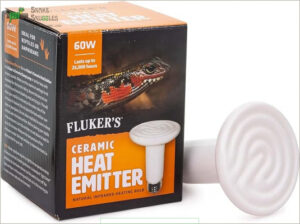
When temperatures drop below your python’s comfort zone, you’ll need reliable backup heat that won’t disturb their nocturnal nature.
Ceramic heat emitters deliver consistent warmth without any light emission, making them perfect for nighttime temperature maintenance.
Unlike traditional bulbs that burn out quickly, these durable units can run 24/7 for years while converting nearly all electricity into pure heat.
You’ll want to pair yours with a thermostat for precise control and always mount it outside the enclosure to prevent burns, ensuring a safe and controlled environment with reliable backup heat.
Best For: Reptile and amphibian owners who need a safe, non-light-emitting heat source for maintaining stable nighttime temperatures, especially for nocturnal species like pythons.
- Does not provide instant heat and may take time to reach full temperature.
- Requires proper fixture and mounting outside the enclosure to prevent burns.
- Lower output compared to high-wattage bulbs may not suit very large or open enclosures.
- Provides steady, 24-hour heat without disrupting animals’ natural night cycle.
- Highly durable and efficient, often outlasting incandescent bulbs and operating quietly.
- Compatible with thermostats for precise temperature control and safety.
5. Reptisun Led Terrarium Lighting Hood

Ideal illumination transforms your python’s terrarium from basic housing into a thriving ecosystem.
You’ll want the ReptiSun LED hood’s 6500K daylight LEDs to establish natural circadian rhythms for your Children’s python.
The modular design lets you replace panels individually, while red LEDs at 620nm promote live plant growth in bioactive setups.
Blue LEDs create nighttime lunar effects, supporting your snake’s nocturnal behavior.
Though energy-efficient with 20,000-hour lifespans, you’ll still need separate UVB lighting for complete reptile wellness.
Best For: Keepers of Children’s pythons or other reptiles needing naturalistic, energy-efficient lighting and live plant support in mid-sized terrariums.
- Modular LED panels easily swap out for upgrades or repairs.
- Red, blue, and daylight LEDs replicate full-spectrum lighting for plant growth and snake activity.
- Cool operation and IP65 water resistance make it safe for humid, bioactive setups.
- No built-in UVB, so a separate UVB light is needed for your snake’s health.
- Legs and clamp can become unstable when fully extended.
- Some durability issues reported, with modules failing within a month.
6. Reptile Terrarium Heat Lighting Timer
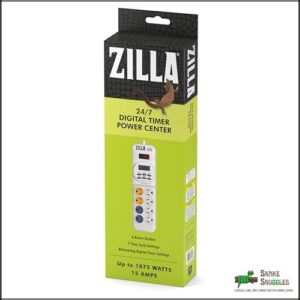
Automated timers revolutionize Children’s python care by maintaining consistent day-night cycles without daily intervention.
You’ll eliminate the stress of remembering to switch lights and heat sources while supporting your snake’s natural circadian rhythm.
These digital controllers prevent overheating accidents and guarantee proper temperature drops from 85°F daytime basking to cooler nighttime conditions.
Programming takes patience initially, but once configured, your python enjoys professional-grade environmental control that promotes healthy feeding patterns and reduces overall stress levels.
This setup allows for a consistent day-night cycle, which is essential for the well-being of the python.
Best For: Reptile owners seeking automated, reliable control over lighting and heating cycles to support animal health and reduce daily maintenance.
- Initial setup and programming can be confusing and time-consuming.
- Limited to a 3-foot power cord and indoor use only.
- Occasional time drift or memory resets may require periodic manual adjustment.
- Centralizes timer control for both lights and heat, supporting natural circadian rhythm.
- Reduces risk of overheating or forgotten lights with automated scheduling and manual override features.
- Consistent day-night cycles promote lower stress and healthier feeding patterns.
7. reptile terrarium humidifier misting system
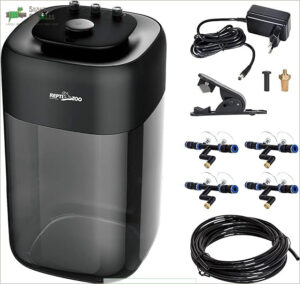
Maintaining proper humidity between 50-60% becomes effortless with an automatic misting system for your Children’s python enclosure.
These programmable units deliver precise moisture levels through adjustable spray nozzles, preventing dehydration and supporting healthy shedding cycles.
You’ll appreciate the quiet operation and visual water level indicators that make monitoring simple.
Most systems support multiple nozzles, letting you create humidity gradients throughout the terrarium for ideal microclimate control.
Best For: Reptile keepers looking for hands-free, reliable humidity control in terrariums, especially for sensitive species like Children’s pythons.
- Maintains precise, consistent humidity with programmable misting cycles.
- Supports multiple spray nozzles for customizable microclimate zones.
- Operates quietly with easy-to-monitor water levels and minimal setup.
- Requires regular cleaning to prevent bacteria and nozzle clogs.
- Improper setup or over-misting can cause flooding or mold growth.
- Some users report reliability issues if neglected or run dry.
8. Natural Green Sphagnum Moss Terrarium
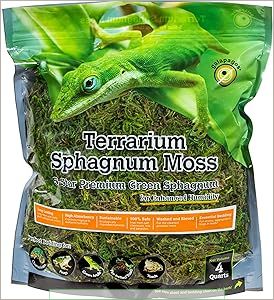
Natural green sphagnum moss transforms your Children’s python terrarium into a humidity powerhouse.
This long-fiber moss holds moisture effectively, supporting your snake’s shedding process while creating a naturalistic environment.
You’ll find it enhances the visual appeal with vibrant green color that won’t fade quickly.
The moss requires regular maintenance to prevent mold growth, but it’s sustainably sourced and non-toxic.
Simply spread it in humid hides or throughout the enclosure to maintain ideal moisture levels for your python’s health.
Best For: Reptile owners, especially those with Children’s pythons, looking to boost humidity and create a visually appealing, naturalistic habitat.
- Maintains humidity and supports healthy shedding for reptiles.
- Vibrant, natural green color adds aesthetic appeal to terrariums.
- Sustainably sourced, non-toxic, and easy to spread.
- Requires regular maintenance to prevent mold.
- May need multiple bags for larger enclosures.
- Perceived quantity can be less due to packaging with air.
Childrens Python Care and Maintenance
Once you’ve set up the perfect habitat, maintaining your Children’s python requires consistent attention to feeding, handling, and health monitoring.
Proper care guarantees your Antaresia childreni thrives throughout its 15-20 year lifespan while developing into a calm, handleable companion.
Diet and Feeding Requirements
Your children’s python needs a proper snake diet to thrive.
These constrictors require whole prey like frozen mice, with prey size matching your snake’s thickest body section.
Feeding frequency varies by age—juveniles eat weekly while adults feed every 10-14 days.
- Prey Size: Choose frozen mice equal to your snake’s widest point
- Feeding Frequency: Weekly for juveniles, biweekly for adults
- Supplementation Needs: Whole prey provides complete nutrition without extras
Handling and Socialization Techniques
Your Children’s python’s docile temperament makes safe handling straightforward once you understand their cues.
Start with brief, gentle sessions to build trust through consistent temperament training. Watch for defensive postures like S-curves or rapid tongue flicking—these signal stress and mean it’s time to back off.
Remember to supervise children closely, as safe handling practices are essential for both the child and the snake.
Regular interaction frequency helps reduce stress, but avoid handling during shedding or after feeding when your snake needs rest.
Health Checks and Common Issues
Regular health monitoring prevents serious snake health problems before they escalate.
Watch for open-mouthed breathing or bubbles at nostrils—clear signs of respiratory infections.
Check for tiny black mites around eyes and chin grooves.
Shedding problems appear as retained skin patches, often indicating humidity issues.
Scale rot presents as discolored or blistered skin.
Obesity risks increase when you overfeed your python, creating disproportionate head-to-body ratios that require immediate dietary adjustments.
Childrens Python Growth and Development
Your python’s growth depends on genetics, diet quality, and environmental conditions like temperature and humidity.
You’ll want to select a healthy juvenile that shows alert behavior and proper feeding responses, then maintain consistent temperatures between 78-88°F to support steady development.
Factors Affecting Growth Rate
Why does your python’s growth rate vary so dramatically?
Temperature gradient plays a vital role—optimal basking zones at 32-38°C accelerate development while poor heating stunts progress.
Feeding frequency determines python size more than prey type, with well-fed juveniles showing fastest growth rates.
Habitat size, genetics, and proper shedding cycles all influence final dimensions, making consistent diet and temperature your primary growth tools.
Maintaining proper humidity, around 50-70% humidity, is also essential for healthy shedding and growth.
Selecting and Purchasing a Healthy Snake
Finding the right Childrens python starts with locating a reliable breeder with solid breeder reputation and ethical sourcing practices.
You’ll want someone who offers a health guarantee and maintains proper quarantine period protocols.
During visual inspection, look for clear eyes, smooth skin, and alert behavior—these indicate good snake health.
A reputable snake breeder will answer your questions openly and provide documentation about the snake’s lineage and care history for your snake purchase.
To guarantee the best health, consider specialized care products.
Providing Optimal Environment for Growth
Your snake’s environment directly impacts its growth potential and overall health.
Create a thermal gradient with basking spots at 88-90°F and cooler areas at 78-80°F using under-tank heaters or ceramic emitters.
Maintain humidity control between 50-60%, increasing during shed cycles, and choose appropriate substrate selection like cypress mulch or aspen shavings for burrowing behavior.
Add enclosure enrichment through hiding spots, climbing branches, and secure habitat features to ensure your snake thrives in its snake habitat setup.
Monitor snake temperature and humidity levels regularly to guarantee your Childrens python thrives.
Frequently Asked Questions (FAQs)
Are children’s Python a good snake?
Yes, Children’s pythons make excellent pet snakes. You’ll find them perfect for beginners—they’re docile, non-venomous, and low-maintenance. With proper care, they’ll be your companion for 15-20 years.
What is the scientific name of a children’s Python?
Clearly called Antaresia childreni, this charming python’s scientific classification honors John George Children, the naturalist who first described this Australian species in the 1800s, not its suitability for kids.
What is a children’s Python?
Children’s pythons are small, nonvenomous Australian snakes reaching 3-4 feet long. You’ll recognize their reddish-brown coloration with darker leaf-like markings. They’re beginner-friendly pets with docile temperaments and 20-year lifespans.
How big do children’s pythons get?
You’ll find that adult Children’s pythons typically reach 3-4 feet in length, making them Australia’s smallest python species. They’re perfectly sized for manageable pet ownership.
Can children pythons live in Australia?
Children’s pythons naturally inhabit northern Australia, thriving in Queensland, Northern Territory, and Western Australia’s rocky outcrops, woodlands, and caves where they’ve evolved perfectly for the continent’s warm, humid climate conditions.
Where do children’s Python Live?
Children’s pythons inhabit northern Australia’s diverse landscapes, from Queensland’s rocky outcrops to Western Australia’s caves and the Northern Territory’s woodlands.
You’ll spot them in grasslands, dry forests, savanna, and monsoon regions, expertly hidden in tree hollows and termite mounds, showcasing their ability to thrive in various diverse environments.
What are the different types of children’s pythons?
Like discovering a hidden gem in nature’s treasure chest, you’ll find Children’s pythons aren’t actually multiple types.
There’s just one species, Antaresia childreni, with natural color variations ranging from cream to reddish-brown tones, which is a notable characteristic.
Are children’s pythons good for beginners?
Yes, you’ll find Children’s pythons are excellent beginner snakes. They’re docile, non-venomous, and low-maintenance. Their calm temperament makes handling easy, while their simple care requirements won’t overwhelm new snake owners.
What is a T+ children’s Python?
T+ refers to a genetic mutation affecting tyrosinase activity in children’s pythons.
Think of it as nature’s artistic brush—it creates reduced melanin production, resulting in lighter, more vibrant coloration patterns while maintaining the species’ classic markings and temperament.
What do I need for a children’s Python?
You’ll need a 40-gallon tank, under-tank heater, hiding spots, water dish, cypress mulch substrate, thermometer, and hygrometer. Maintain 78-88°F temperatures with 50-60% humidity for your python’s health.
Conclusion
Success doesn’t happen overnight when mastering this childrens python species guide.
You’ll discover that proper preparation and consistent care create thriving conditions for your Antaresia childreni.
These remarkable pythons reward dedicated keepers with years of fascinating behavior and steady growth.
Remember that temperature gradients, appropriate feeding schedules, and regular health monitoring form the foundation of successful python ownership.
With patience and attention to detail, you’ll build confidence while providing exceptional care for your new reptilian companion.
- https://en.wikipedia.org/wiki/Children's_python
- https://www.thebiodude.com/blogs/snake-caresheets/bioactive-childrens-python-care-sheet
- https://www.reptile-cage-plans.com/articles/snakes/aus-childrens-python-care.html
- https://www.youtube.com/watch?v=2rI87vAH5TI
- https://kids.britannica.com/students/article/python/313104

